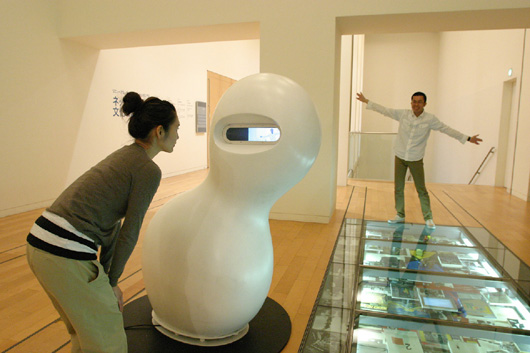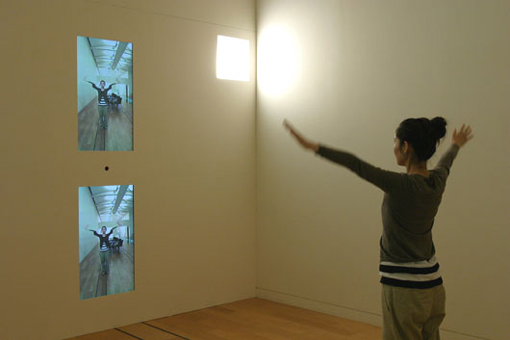"Marshmallow Scope"
2002
"Another Time, Another Space"
1993
2002
"Another Time, Another Space"
1993
IWAI Toshio


If you look into the monitor mounted in the white marshmallow-shaped object, you will see the surrounding landscape changing as if time is going forward and backward or the passengers or objects distorted. What you see is a result of the real time manipulation and deformation of video imagery and the flow of time that was shot with a video camera and stored in the computer.
The predecessor of this "Marshmallow Scope" is "Another Time, Another Space", which was presented in Antwerp, Belgium in 1993. That work presents transformed images of people who came and went through Central Station or moved their bodies in front of the video camera. This video installation creates time and space that are different from reality and uses monitors installed outdoors and public spaces so that anyone can become a performer in this participation-oriented work. "Marshmallow Scope", with its lovely and friendly shape, can serve as a window through which you can look into another world that has a different time-flow from that in the real world we know. IWAI Toshio started animation production after entering university in the early 1980s, and has since presented works that were inspired by the pre-cinematic visual devices, including the phenakistiscope and zoetrope, and interactive works that connect sounds and images. His broad spectrum of activity covers creating animation characters for TV programs, CG system design, computer game software production, a visual media device installed at Ghibli Museum, Mitaka, and a recent media artwork titled "Electroplankton" for Nintendo DS platform.
IWAI Toshio started animation production after entering university in the early 1980s, and has since presented works that were inspired by the pre-cinematic visual devices, including the phenakistiscope and zoetrope, and interactive works that connect sounds and images. His broad spectrum of activity covers creating animation characters for TV programs, CG system design, computer game software production, a visual media device installed at Ghibli Museum, Mitaka, and a recent media artwork titled "Electroplankton" for Nintendo DS platform.
The predecessor of this "Marshmallow Scope" is "Another Time, Another Space", which was presented in Antwerp, Belgium in 1993. That work presents transformed images of people who came and went through Central Station or moved their bodies in front of the video camera. This video installation creates time and space that are different from reality and uses monitors installed outdoors and public spaces so that anyone can become a performer in this participation-oriented work. "Marshmallow Scope", with its lovely and friendly shape, can serve as a window through which you can look into another world that has a different time-flow from that in the real world we know.


 | Video |
Video art came into the world as a new form of technology-based art before the computer-driven media art that we see today became popular. Video is characterized by easy mobility due to progress in portable equipment and electronic image recording and reproduction. After editing and processing of images at the frame level became possible, video has been incorporated into artworks as an alternative visual media. Once computers were able to process images, image manipulation at the pixel level makes video a "material" with increasing plasticity.

